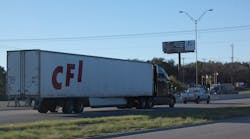Freight volume that continues to climb while trucking capacity shrinks is raising hackles among shippers, according to a range of analysts.
“The shippers we work with are extremely concerned about the macro-economic situation,” Mike Mulqueen, senior director of product management for Manhattan Associates, told FleetOwner.
“The overall expectation [for truck capacity] is that things are going to get tougher,” he said. “Whereas 95% of the motor carriers many of our shippers deal with used to accept their freight, now that’s down to maybe 85%, forcing more of them to go to the spot market – and there are bigger penalties for doing that.”
Simultaneously, the amount of freight being directed toward trucking continues to creep steadily upward. For example, the American Trucking Associations (ATA) for-hire truck tonnage index jumped 3.5% in November, following an increase of 0.5% in October, and year-to-date tonnage is up 3.3% compared to the same period in 2013.
“With strong readings for both retail sales and factory output in November, I’m not surprised that tonnage increased as well,” noted Bob Costello, ATA’s chief economist, in a statement.
“However, the strength in tonnage did surprise to the upside,” he stressed. “The [for-hire tonnage] index has increased in four of the last five months for a total gain of 6.4%. Clearly, the economy is doing well with tonnage on such a robust trend-line.”
Steve Graham, one of the analysts with research firm FTR Transportation Intelligence, noted in a recent blog post that 2015 is looking to be an even better year for the U.S. economy, with even more potential for freight growth.
“Higher wages will spur more spending, construction and investment. The sharp fall in oil prices is a boost for the consumer,” he said. “The most encouraging factor that will provide fuel for economic growth is the rapid decline in joblessness. The economy will approach full employment next year. Wage increases will follow, which in turn will spur spending.”
Though he cautioned that a lot of risk still remains ahead for the global economy – with the Euro-zone and Japan flirting with recession, while China’s economic growth continues throttling back – the road for the U.S. in 2015 looks clear.
“The economy has withstood a lot of bad breaks since the recession ended, but fundamentals look better now than they have in years,” Graham noted. “The economy was fairly good in 2014, but 2015 looks much stronger.”
Yet that is posing a problem for shippers, Manhattan’s Mulqueen said. For starters, even though fuel costs are declining due to record drops in global oil prices, any declines in fuel surcharge payments are going to be offset by significant truck freight rate increases.
Right now, Manhattan is estimating TL rates will climb 6% to 7% while LTL rates are expected to rise between 4% and 5% into next year.
Mulqueen also said the situation is finally forcing many shippers to start addressing what he calls a “need for a new mentality” when it comes to their relationships with motor carriers.
“I still see this a lot: the mentality of, ‘if it is good for the carriers, it is bad for me.’ That mentality is a problem,” he stressed. “So now we’re seeing efforts to finally look at building ‘attractive freight’ even concerning stuff as simple as treating drivers with respect.”
Mulqueen also believes the growing need to address the truck capacity shortage in the face of rising freight volumes is going to drive shippers to rely on more sophisticated transportation modeling systems capable of being more “flexible.”
“Modeling enables organizations to quantify the cost and service implications of changing a variable that impacts transportation,” he pointed out. Some trucking-related questions shippers can use such programs to ask themselves include:
- What are the cost/service implications of dynamic versus static routing?
- What if we were able to open our delivery windows from 2 hours to 4 hours?
- What are the implications if TL and LTL rates each go up 5% annually for the next three years?
“Modeling, at its essence, is used to mimic the future state of a system. In all systems, there is some degree of variability that will exist be they fuel prices, transit times, etc.,” he explained.
As shippers build an operating framework to support the transportation needs of the organization, Mulqueen believes it will be “imperative” that such models are capable of understanding the “probabilistic nature” of a system.
“In other words, as natural variability occurs, the transportation operating model is able to bend and not break,” he stressed. “That means for instance finding ways for shippers to gain more efficiencies while turning trucks for their carriers faster.”



